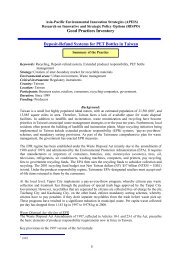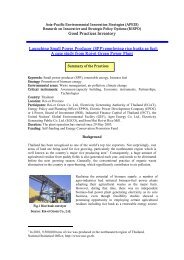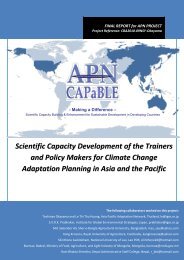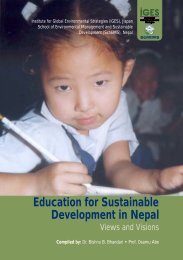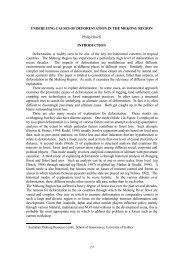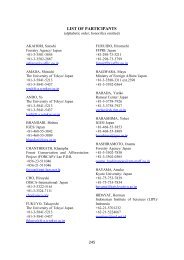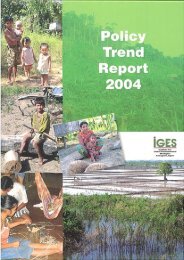final evaluation report akk_iges_final.pdf - IGES EnviroScope
final evaluation report akk_iges_final.pdf - IGES EnviroScope
final evaluation report akk_iges_final.pdf - IGES EnviroScope
Create successful ePaper yourself
Turn your PDF publications into a flip-book with our unique Google optimized e-Paper software.
APFED Project Final Evaluation Report 2011<br />
the historical level could be a safe approach but may not be termed as ‘climate proof approach’ in<br />
absence of reliable climate change impact predictions since nobody can tell if 2 feet above historical<br />
floods would suffice and for how long. One of the limitations is that there are cost implications as<br />
well. Raising the homesteads from 2 feet above historical flood level to 4 feet above historical flood<br />
levels costs more which means additional financial burden for the implementing agencies and for the<br />
communities who share the costs.<br />
While it has been a challenge for the implementing agencies to implement these projects, it becomes<br />
even more challenging when the local governments consider these projects as ‘out of their mandate’.<br />
It is often hard to make them believe that there is a value to integrate the idea of raising homesteads<br />
within government driven programs or to introduce training programs on floating vegetable<br />
cultivation since they consider these are outside their mandate. The limited resources with the local<br />
governments make it even more difficult to find any engaging point with them. The best one could<br />
expect is to invite a government official to distribute project benefits to the beneficiaries. The<br />
challenge is how to move from this point of engagement to the point of even more stronger<br />
engagement such as joint implementation of projects? The project has certainly helped in engaging the<br />
local governments to the first step.<br />
The following recommendations appear to be valid for implementing climate change adaptation<br />
projects:<br />
1) Climate change adaptation cannot be isolated from any other development efforts. Both<br />
development and adaptation are closely interlinked, particularly at the local scale we experienced.<br />
2) There is limited knowledge amongst local communities on what climate change is, why it is<br />
happening and how to respond to it. While improving understanding of climate change amongst local<br />
communities might be important, communities are interested in understanding how to cope with, and<br />
adapt to, change – of which climate change is just one part.<br />
3) Good progress has been made so far in Faridpur and this progress has established a good point to<br />
move forwards from. But local governments and NGOs could play a even greater role in promoting<br />
local adaptation initiatives by close closely collaborating with each other.<br />
4) Local actions could be more closely based on thorough or ‘scientific’ climate change vulnerability<br />
assessments for which the knowledge and tools be made available.<br />
5) Gender aspects could also have been better addressed by the local initiatives, bearing in mind the<br />
strong involvement of women in the self-help groups being formed for promoting rural<br />
entrepreneurship.<br />
47



